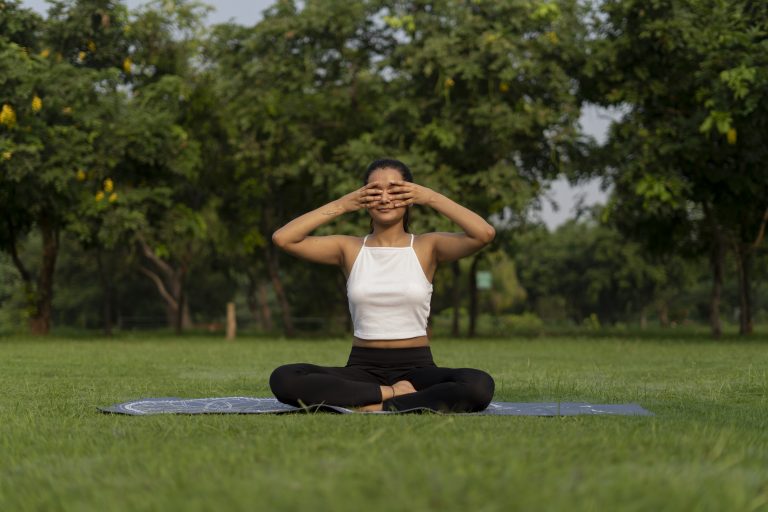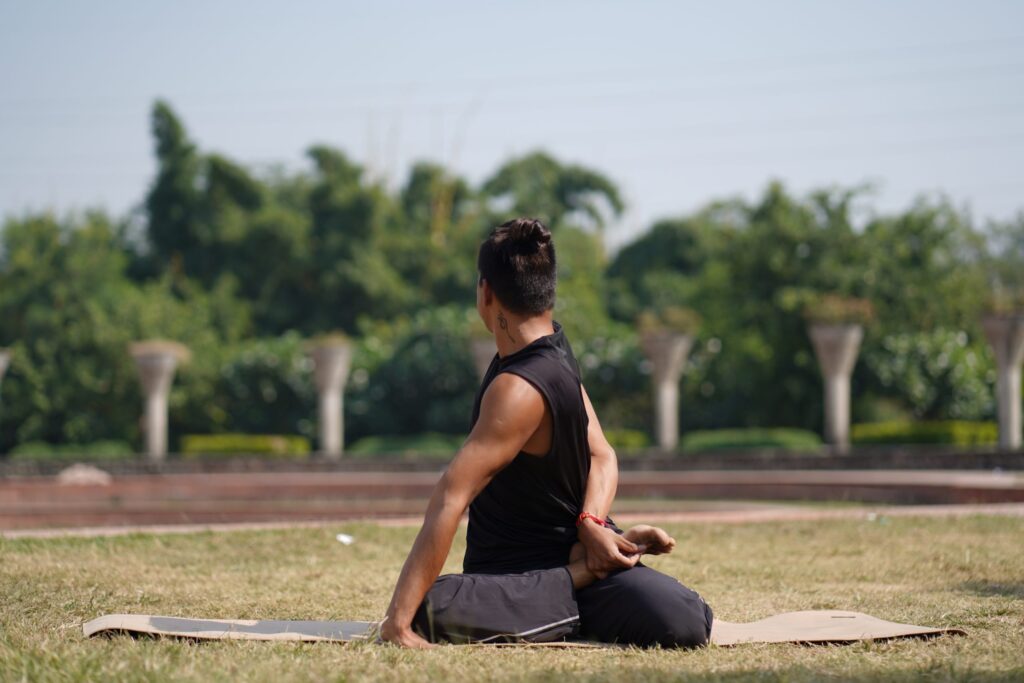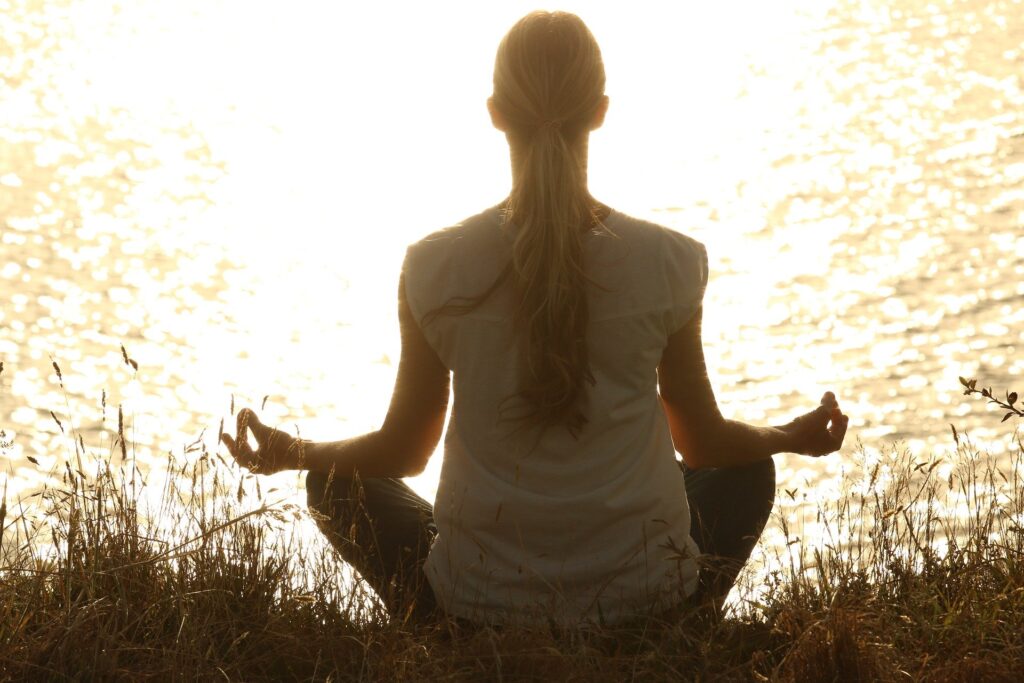Shanmukhi Mudra ( षण्मुखी मुद्रा ) is also known as ‘Yoni Mudra’, ‘Looking Within’ and ‘Padmasana with Shanmukhi Mudra‘. This mudra helps to stimulate Anahata Chakra and withdraw our consciousness from the external world. In this article, we would discuss about various such health benefits, steps and precautions for performing ‘Shanmukhi Mudra’.
The Sanskrit name Shanmukhi Mudra ( षण्मुखी मुद्रा ) is the combination of three words — Shad ( षष्ट ) means ‘Six’, Mukhi meaning ‘face’ or ‘openings’ and ‘Mudra’ means ‘hand gesture’. In this mudra, a yogi need to sit in Padmasana with closed eyes, followed by raising hands in front of face with elbows pointing outwards to close openings of sense organs.

Shanmukhi mudra is a part of Mana Mudra that requires active involvement of all the five senses by closing seven openings – ears, nostrils, eyes and mouth. The regular practice of this mudra aids to stay longer in deeper meditation by withdrawing senses from worldly environment and improving self-awareness.
As per ancient Hindu scriptures, Goddess Shanmukhi is the serpent deity with six faces. It’s believed by doing Shanmukhi mudra daily, Kundalini – the dormant energy gets awaken. Plus, this mudra is a type of Nada yoga that helps to connect to the inner sounds and stimulates Ida, Pingala and Sushumna nadis.
How to practice Shanmukhi Mudra
Following are the step – by – step instructions to follow for the practice of Shanmukhi Mudra :
Step 1 :
- Begin the practice of Shanmukhi Mudra by sitting cross-legged in any meditative pose like Padmasana or Sukhasana.
Step 2 :
- Keep your spine erected and raise your arms in front of your face with elbows pointing outward in line with shoulders.
Step 3 :
- Lower your shoulders down the floor & fix sit bones into the floor to distribute your bodyweight equally on both sides.
Step 4 :
- Now, start blocking all sense organs in a succession. Begin by closing the ears by placing the thumbs gently on them.
Step 5 :
- Place your index fingers gently on the eyelids to close your eyes & try to push your eyelashes in the upward direction.
Step 6 :
- Breathe in fully and block your nostrils partially with middle fingers. hold your breathe as long as you are comfortable.
Step 7 :
- Finally position your ring fingers above and little fingers below your lips on both sides respectively to close the mouth.
Step 8 :
- Don’t press too hard & maintain the posture for about 4 – 5 minutes. Be aware of rhythmic breathing during the mudra.
Step 9 :
- Inhale slowly to release Shanmukhi mudra by removing the fingers form nostrils then exhale while practicing Brahmari.
Step 10 :
- Keep the eyes closed as you start unblocking openings of your other sense organs then place your hands on the knees.
Step 10 :
- Breathe deeply to relax your body completely, then start opening your eyes & become aware of all the external sounds.
Modifications and Variations
- Some common variations of Shanmukhi mudra are Jnana mudra, Pala mudra, Abhaya hridaya mudra and Vitarka mudra.
- If you can’t hold elbows at shoulders level during Shanmukhi Mudra, so you can lower your elbows by bending at wrists.
Precautions and Contraindications
- Avoid the practice of Shanmukhi Mudra if you are suffering from glaucoma as it may put pressure on eyes and facial muscles.
- Avoid the practice of Shanmukhi Mudra If you’re suffering from migraines, asthma, high blood pressure or any heart problems.
- You should refrain from holding your breath for longer periods if you are suffering from any respiratory disease like bronchitis.
- You should go slow with your practice of Shanmukhi Mudra if you are suffering from depression or have such medical history.
- Don’t press the eyes and ears too hard while performing Shanmukhi Mudra as it may lead to ear pain, headache or irritations.
- Pregnant women should refrain from practice of Shanmukhi Mudra alone, which should be followed by Bhramari pranayama.
Top Health Benefits of Shanmukhi Mudra
Following are the major Health Benefits of Shanmukhi Mudra that you may attain with regular practice :
- Shanmukhi Mudra helps to activate Ajna Chakra that enhance focus, concentration and the sense of self consciousness.
- The regular performance of Padmasana with Shanmukhi Mudra helps to cure various infections of eyes, nose and throat.
- It’s believed daily practice of Shanmukhi Mudra helps to awaken Kundalini, the dormant energy near Muladhara Chakra.
- Shanmukhi mudra drives mind into state of Pratyahara i.e. withdrawal of senses that aids in Dharana, Dhyana & Samadhi.
- Shanmukhi Mudra improves the vision and hearing ability, relieves vertigo, tinnitus and other age – related hearing loss.
- The regular performance of Shanmukhi Mudra helps to balance and cleanse Panchatatva – five elements of your body.
- Shanmukhi Mudra promotes clear thinking, boosts memory, cures dementia, removes negative emotions & distractions.
- Shanmukhi Mudra not only rejuvenates your eyes & facial muscles but also improves functioning of the nervous system.
- The practice of Shanmukhi Mudra aids to reduce harmful and toxic emotions such as stress, anger, anxiety and irritation.
Preparatory Mudras
- Unmani Mudra
- Agochari Mudra
- Anuloma Viloma
- Trataka Pranayama
Follow-Up Mudras
- Bhoochari Mudra
- Kaki Mudra
- Akashi mudra
Conclusion
The regular practice of Shanmukhi Mudra offers numerous health benefits – calms your mind, brings mental clarity, enhances attention and self-esteem, makes your face glowing, re-energizes body, increases focus and concentration levels etc.
We really hope that this article would be useful guide for your practice of Shanmukhi Mudra. Try out this wonderful mudra to boost mind-body coordination and share your thoughts, views and suggestions on this post in the comment section.
Also Read :
FAQs Related to Shanmukhi Mudra and its Benefits
How the practice of Shanmukhi Mudra different from Bhramari Pranayama ?
During the practice of both Shanmukhi Mudra and Bhramari Pranayama Bumble Bee Breathe, a yogi needs to block all the sensory organs with his fingers. But in case of Bhramari one have to additionally create a humming sound with vibrations as he breathe out in the posture. The practice of these exercises promotes healthy mind-body coordination and improved flow of prana energy



